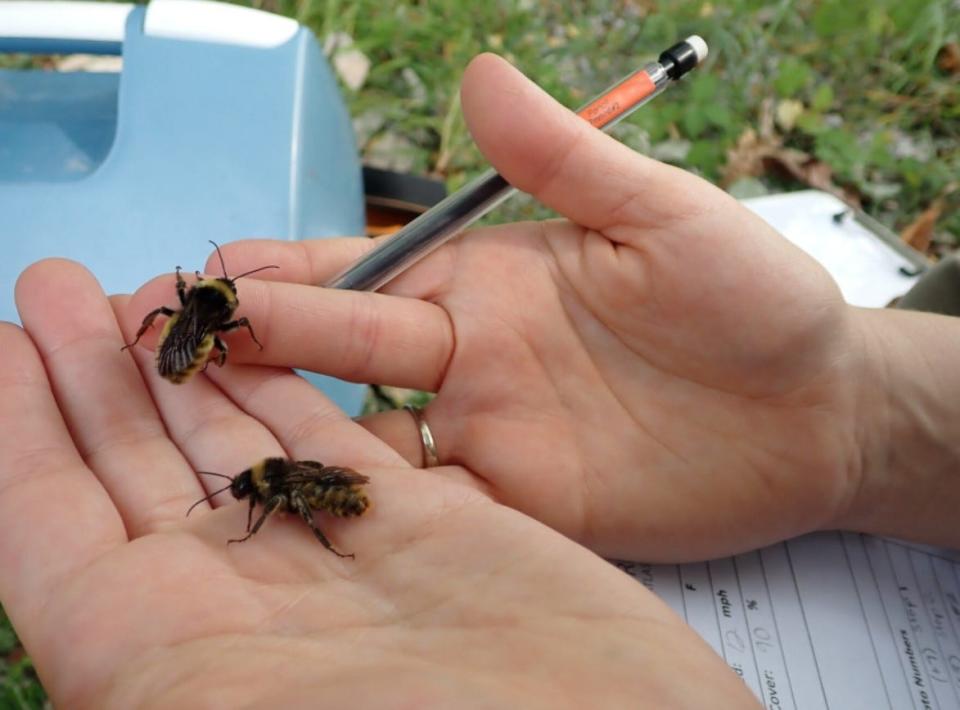Got an eye for bumblebees? These scientists want your help counting them in Kansas.
Scientists want Kansans in every corner of the state to help count bumblebees — those fuzzy, good-natured harbingers of summer.
You don’t need a biology degree. Just enthusiasm and some training, which scientists offer online and, this week, in person in Kansas City, Wichita and at the Tallgrass Prairie National Preserve.
That’s what it takes to help expand a program that already pools the efforts of hundreds of volunteers in neighboring Missouri and Nebraska, where they have recorded 7,000 bumblebee sightings in just a few short years.
Insect populations are shrinking globally, but especially in the Midwest. That threatens humans and other life.

Bees are the most effective pollinators of food supply
When it comes to sustaining plants — the photosynthetic godsends that allow the rest of us to eat and breathe — bees are tops.
Wasps, bats and other critters pollinate flowers, too, but bees shine extra bright.
“They are by far the most effective pollinator,” said Katie Lamke, a biologist with the Xerces Society conservation group. “They’re constantly gathering pollen and nectar because that’s their only source of food.”
The vast majority of flowering plants worldwide can’t reproduce without pollinators. Wind won’t do the trick.
So, insects do most of the work and, Lamke said, “most times, that insect is a bee.”
No wonder that scientists are racing to learn more about bees. North America has thousands of bee species, about which not enough is known. Of the continent’s approximately 50 bumblebee species, research suggests one-quarter of them face “dramatic population declines,” the Xerces Society says.
Xerces runs the Bumble Bee Atlas, which this year will grow to include Kansas, California and the Dakotas. Bumblebees make a relatively easy focus for community science because they’re easier to spot and recognize than smaller bees.
Training will teach volunteers how to trap and photograph bees
Volunteers learn just the right way to swish a net, trap a bumblebee in a jar, briefly chill the jar on ice to slow the insect down, photograph the bee and release it unharmed. Later, people report their sightings to Xerces scientists, who study the notes and review the photos to confirm species and learn what kinds of plants the bees visited.
The collective effort produces far more information on the creatures than Xerces biologists would have time and resources to gather alone.
What are the chances you’ll get stung?
In seven years of studying and handling bumblebees, Lamke says she’s only sustained one or two stings.
“Bumble bees are quite docile animals,” she said. “It is very uncommon to be stung when surveying.”
Still, anyone with a bee allergy should take extra precautions.
Here are the training opportunities for bumblebee volunteers
Kansans who want to try their hand at helping scientists study bumblebees can watch online training and register for in person events:
• June 4 at the Anita B. Gorman Discovery Center in Kansas City, Mo.
• June 25 at the Great Plains Nature Center in Wichita.
• June 26 at Tallgrass Prairie National Preserve near Strong City.
Celia Llopis-Jepsen reports on consumer health for the Kansas News Service.
This article originally appeared on Topeka Capital-Journal: Volunteers needed to trap and photograph bumblebees for Kansas count

